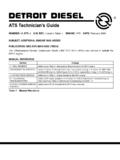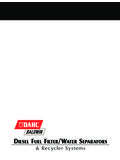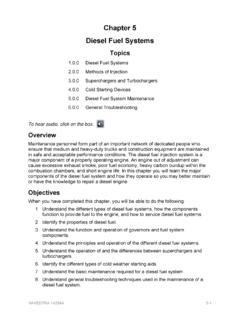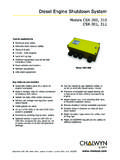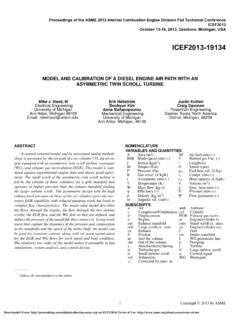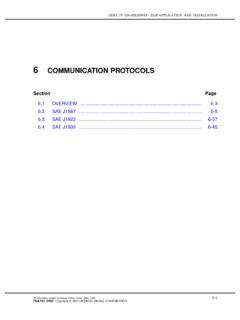Transcription of Module 14: Electronic Fuel Injection Diagnosis and Repair
1 2012 Jones & Bartlett Learning1 CDX diesel EnginesModule 14: Electronic fuel Injection Diagnosis and Repair Active codes are codes describing a condition that is currently present to alert the driver or service technician of abnormal parameters. Actuator is a device that performs work in response to an Electronic signal. Bypass circuit is a circuit, usually temporary, used to substitute for an existing circuit, typically for test purposes. Calibration is the adjustment of a sensor signal. Computer data link is a connection between two Electronic devices for communication purposes and is used for programming and troubleshooting. Data is information in numerical form that can be digitally transmitted or processed. Diagnostic code is a digital readout that identifies a problem or event in an Electronic : This may also be called a fault code or trouble code. Driver is a transistor in the output section of the ECM used to turn on or off various actuators in the system.
2 Electronic control Module (ECM) is a computerized device that monitors other Electronic parts and acts as a governor in Electronic fuel : This is the brains or command center for the Electronic system. Harness is a wiring bundle connecting all Electronic components. Historical or inactive codes are codes stored in ECM memory. Microprocessor integrated circuit within a microcomputer controls information flow within the computer. On-demand test is a self-test that the technician initiates and is run from a program in the processor. Parameter is a programmable value that affects the characteristics or behavior of the engine and/or vehicle; some examples are high idle RPM, idle speed, and PTO speed. Personality Module is an Electronic Module that stores individual vehicle parameters for the system being : This Module allows for several vehicle features to be reset, such as road speed, cruise control set points, and speedometer calibrations.
3 Potentiometer is an electromechanical device that senses the position of a mechanical component. Pulse width is the length of time an actuator, such as an injector, remains energized. Random access memory (RAM) is a type of memory used to store information and can be written to and read from. Read only memory (ROM) is a type of memory used to store information permanently, and it cannot be written over. Reference voltage is regulated voltage supplied by the Electronic control Module to a sensor and is used by a sensor to generate a signal voltage. Sensor is a device used to detect and convert a change in a measurement (such as pressure, temperature, or movement) into an electrical signal. Signal is a voltage or waveform used to transmit information, usually from a sensor to the Electronic control Module . Solenoid is an Electronic device that controls the amount of fuel delivered by the injector.
4 Thermistor is a sensor used to determine temperature. Threshold value is the value stored in the ROM portion of the ECM, which is used for comparison to a sensor s : If the value is not within the parameters of the threshold value, a service code is recorded. Transducer is a device that converts a mechanical signal to an electrical signal and is used to sense pressure. TERMS AnD DEfInITIOnS fuel fLOw THROugH An Electronic fuel SySTEM PARTS Of An Electronic unIT InJECTOR ADvAnTAgES Of Electronic fuel Injection COMMOn TyPES Of Electronic fuel Injection SySTEMS BASIC CATEgORIES Of Electronic COMPOnEnTS COMMOn Electronic SEnSOR COMMOn Electronic ACROnyMS SPECIALTy TOOLS uSED fOR Electronic Diagnosis BASIC TyPES Of DIAgnOSTIC CODES Electronic IDEnTIfICATIOn MESSAgE CODEST erms and Definitionsready for review 2012 Jones & Bartlett Learning2 CDX diesel EnginesModule 14: Electronic fuel Injection Diagnosis and Repair Step 1: fuel is drawn from the tank through a possible primary fuel filter (or strainer) and enters the fuel transfer pump.
5 Step 2: fuel then goes through a possible distribution block, priming pump, secondary fuel filter, cooler plate on the ECM, and to the cylinder head inlet passage. Step 3: fuel is sent to the injectors. Step 4: The ECM senses the timing and sends a signal to the injector solenoid to energize it. Step 5: The energized solenoid opens the fuel flow through an injector body, which is pushed by a plunger operated by the cam lobe on the engine. Step 6: fuel is pushed down to the Injection nozzle and then sprayed into the combustion chamber under very high pressure. Step 7: The ECM deenergizes the solenoid, which shuts off the fuel . Step 8: The cam lobe rotates allowing the plunger to lift, ready for the next stroke. Step 9: Return fuel from the injector is routed back to the fuel Flow Through an Electronic fuel Systemready for reviewParts of an Electronic Unit Injectorready for review Injector follower Injector follower spring Injector body Plunger O-ring fuel outlet opening Injector nut Check valve Injector valve spring needle valve Spray tip Spring cage Check valve cage Spacer fuel inlet opening fuel supply chamber Poppet control valveAdvantages of Electronic fuel Injectionready for review Improved engine governing, timing, and fuel /air ratios Improved engine performance Reduced fuel consumption Reduced emission levels Enhanced cold starting Improved Diagnosis of engine malfunctions resulting in: Reduced troubleshooting (down) time Reduced labor costs Increased flexibility Parameters can be changed electronically, instead of manually.
6 Parameters can be changed so the vehicle can operate at different loads, altitudes, and terrains. Improved engine protection The engine can be programmed to shut down before dangerous limits are reached. The system is more tamper resistant with multilevel security. Engine warm-up can be Types of Electronic fuel Injection Systemsready for review In-line Injection pump with an Electronic governor Distributor-type Injection pump with an Electronic governor Electronic unit injectors Hydraulically operated and electronically controlled unit injectors (HEuI) 2012 Jones & Bartlett Learning3 CDX diesel EnginesModule 14: Electronic fuel Injection Diagnosis and Repair Input components include sensors and switches and send electrical signals to the ECM. The control component the Electronic control Module (ECM) contains the microcomputer, voltage reference regulator, input conditioners, and output drivers and receives input signals and sends output signals.
7 Output components include Electronic components that perform work, such as solenoids, and electrical warning devices, and receive electrical signals from the Categories of Electronic Componentsready for reviewCommon Electronic Sensorready for review Atmospheric pressure sensor Boost pressure sensor (inlet manifold air pressure) Coolant level sensor Coolant temperature sensor Engine speed/timing sensor fuel temperature sensor Intake manifold air temperature sensor Oil pressure sensor Oil temperature Synchronous reference Throttle position sensor Timing reference vehicle speed sensor (rotation of gear teeth in the drive train)Common Electronic Acronymsready for review CEL: Check engine light CELECT: Cummins electronically controlled fuel Injection system DDEC Detroit: Detroit diesel Electronic control DDL: Diagnostic data link DDR: Diagnostic data reader ECAP: Electronic control analyzer and programmer (Caterpillar) ECM: Electronic control Module ECuI: Electronically controlled unit injector EDu: Electronic distributor unit EEPROM: Electronically erasable programmable read only memory EuI: Electronic unit injector HEuI: Hydraulically actuated, electronically controlled, unit injectors ICM: Ignition control Module IDM: Ignition driver Module (distributor) IPR: Injection pressure regulator PROM: Programmable read only memory SEL: Stop engine lightSpecialty Tools Used for Electronic Diagnosisready for review Adapter cables, breakout T cables, and probes are used with service tools in order to access the measurements of signals.
8 A brass brush for Electronic Injection nozzle tips are used for cleaning nozzle tips. Diagnostic jumper wires are used for jumping terminals when troubleshooting. A digital multimeter (or DvOM) is used for checking voltages and resistance. An Electronic service (scan) tool is a hand-held scanning device used to access diagnostic and programming information in order to locate problems in the Electronic system. Injector tube installation/removal tools are used to replace defective injector tubes. An oscilloscope is used for visually checking the amount of voltage by observing visible wave forms on a fluorescent screen. A personal computer (PC) with diagnostic software is used to read diagnostic codes, change parameters, and obtain engine monitoring information. A PROM removal tool is used for removing defective memory chips or upgrading memory chips. A terminal crimping tool is used for pulling defective terminals.
9 A testing harness is typically inserted between two ends of a connector to permit normal circuit operation while measuring voltages. 2012 Jones & Bartlett Learning4 CDX diesel EnginesModule 14: Electronic fuel Injection Diagnosis and Repair Cylinder faults Injector faults Temperature out of normal range Pressure out of normal range Speeds out of normal range fluid levels below normal voltage above or below normal or shorted Current above or below normal, open, or groundedBasic Types of Diagnostic Codesready for reviewElectronic Identification Message Codesready for review SAE fault codes are standardized throughout the industry to identify Electronic problems. MID Message identifierNote: This identifies the communication device sending the message. for example, MID 128 identifies the diesel engine as the communication device. fMI failure mode identifier SID System (or subsystem) identifier PID Parameter identifierNote: The fMI, SID, and PID narrow down the problem area to a specific sensor or other Electronic output device.
10 This will tell the service technician where to start. flash codes are non-standardized numbering systems developed by different manufacturers to identify Electronic problems. An example is a DDECIII flash code 66 that identifies an engine knock sensor input fault.





